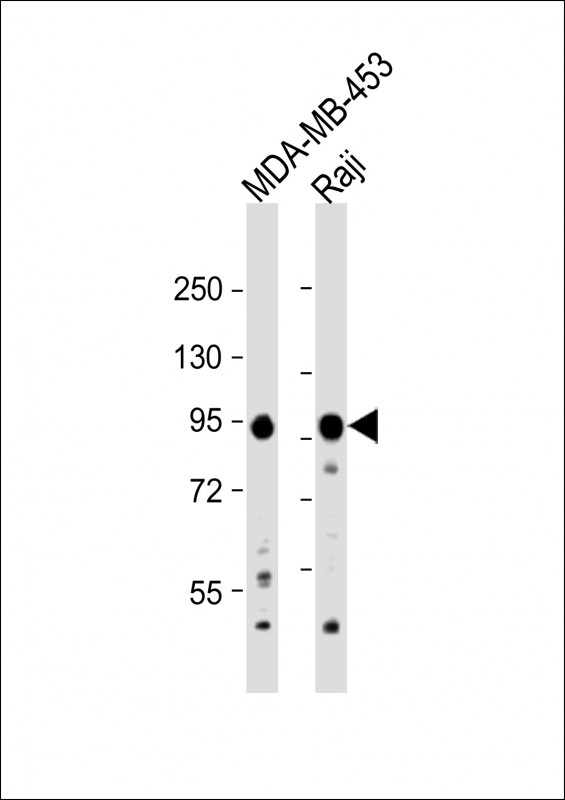AXIN1 Antibody (C-term)
Affinity Purified Rabbit Polyclonal Antibody (Pab)
- SPECIFICATION
- CITATIONS
- PROTOCOLS
- BACKGROUND

Application
| IHC-P, WB, E |
|---|---|
| Primary Accession | O15169 |
| Other Accession | NP_851393.1 |
| Reactivity | Human |
| Host | Rabbit |
| Clonality | Polyclonal |
| Isotype | Rabbit IgG |
| Calculated MW | 95635 Da |
| Antigen Region | 710-738 aa |
| Gene ID | 8312 |
|---|---|
| Other Names | Axin-1, Axis inhibition protein 1, hAxin, AXIN1, AXIN |
| Target/Specificity | This AXIN1 antibody is generated from rabbits immunized with a KLH conjugated synthetic peptide between 710-738 amino acids from the C-terminal region of human AXIN1. |
| Dilution | WB~~1:1000 IHC-P~~1:10~50 |
| Format | Purified polyclonal antibody supplied in PBS with 0.09% (W/V) sodium azide. This antibody is purified through a protein A column, followed by peptide affinity purification. |
| Storage | Maintain refrigerated at 2-8°C for up to 2 weeks. For long term storage store at -20°C in small aliquots to prevent freeze-thaw cycles. |
| Precautions | AXIN1 Antibody (C-term) is for research use only and not for use in diagnostic or therapeutic procedures. |
| Name | AXIN1 |
|---|---|
| Synonyms | AXIN |
| Function | Component of the beta-catenin destruction complex required for regulating CTNNB1 levels through phosphorylation and ubiquitination, and modulating Wnt-signaling (PubMed:12192039, PubMed:27098453, PubMed:28829046). Controls dorsoventral patterning via two opposing effects; down-regulates CTNNB1 to inhibit the Wnt signaling pathway and ventralize embryos, but also dorsalizes embryos by activating a Wnt-independent JNK signaling pathway (PubMed:12192039). In Wnt signaling, probably facilitates the phosphorylation of CTNNB1 and APC by GSK3B (PubMed:12192039). Likely to function as a tumor suppressor. Enhances TGF-beta signaling by recruiting the RNF111 E3 ubiquitin ligase and promoting the degradation of inhibitory SMAD7 (PubMed:16601693). Also a component of the AXIN1- HIPK2-TP53 complex which controls cell growth, apoptosis and development (PubMed:17210684). Facilitates the phosphorylation of TP53 by HIPK2 upon ultraviolet irradiation (PubMed:17210684). |
| Cellular Location | Cytoplasm. Nucleus. Membrane {ECO:0000250|UniProtKB:O35625} Cell membrane {ECO:0000250|UniProtKB:O35625}. Note=MACF1 is required for its translocation to cell membrane (By similarity). On UV irradiation, translocates to the nucleus and colocalizes with DAAX (PubMed:17210684). {ECO:0000250|UniProtKB:O35625, ECO:0000269|PubMed:17210684} |
| Tissue Location | Ubiquitously expressed. |

Thousands of laboratories across the world have published research that depended on the performance of antibodies from Abcepta to advance their research. Check out links to articles that cite our products in major peer-reviewed journals, organized by research category.
info@abcepta.com, and receive a free "I Love Antibodies" mug.
Provided below are standard protocols that you may find useful for product applications.
Background
This gene encodes a cytoplasmic protein which contains a regulation of G-protein signaling (RGS) domain and a dishevelled and axin (DIX) domain. The encoded protein interacts with adenomatosis polyposis coli, catenin beta-1, glycogen synthase kinase 3 beta, protein phosphate 2, and itself. This protein functions as a negative regulator of the wingless-type MMTV integration site family, member 1 (WNT) signaling pathway and can induce apoptosis. The crystal structure of a portion of this protein, alone and in a complex with other proteins, has been resolved. Mutations in this gene have been associated with hepatocellular carcinoma, hepatoblastomas, ovarian endometriod adenocarcinomas, and medullablastomas. Two transcript variants encoding distinct isoforms have been identified for this gene.
References
Sue Ng, S., et al. Biol. Chem. 391 (2-3), 171-180 (2010) :
Yang, L.H., et al. Mol. Cancer 9, 25 (2010) :
Wooten, E.C., et al. PLoS ONE 5 (1), E8830 (2010) :
Kameoka, M., et al. AIDS Res. Hum. Retroviruses 25(10):1005-1011(2009)
Li, Q., et al. Nat. Cell Biol. 11(9):1128-1134(2009)
If you have used an Abcepta product and would like to share how it has performed, please click on the "Submit Review" button and provide the requested information. Our staff will examine and post your review and contact you if needed.
If you have any additional inquiries please email technical services at tech@abcepta.com.













 Foundational characteristics of cancer include proliferation, angiogenesis, migration, evasion of apoptosis, and cellular immortality. Find key markers for these cellular processes and antibodies to detect them.
Foundational characteristics of cancer include proliferation, angiogenesis, migration, evasion of apoptosis, and cellular immortality. Find key markers for these cellular processes and antibodies to detect them. The SUMOplot™ Analysis Program predicts and scores sumoylation sites in your protein. SUMOylation is a post-translational modification involved in various cellular processes, such as nuclear-cytosolic transport, transcriptional regulation, apoptosis, protein stability, response to stress, and progression through the cell cycle.
The SUMOplot™ Analysis Program predicts and scores sumoylation sites in your protein. SUMOylation is a post-translational modification involved in various cellular processes, such as nuclear-cytosolic transport, transcriptional regulation, apoptosis, protein stability, response to stress, and progression through the cell cycle. The Autophagy Receptor Motif Plotter predicts and scores autophagy receptor binding sites in your protein. Identifying proteins connected to this pathway is critical to understanding the role of autophagy in physiological as well as pathological processes such as development, differentiation, neurodegenerative diseases, stress, infection, and cancer.
The Autophagy Receptor Motif Plotter predicts and scores autophagy receptor binding sites in your protein. Identifying proteins connected to this pathway is critical to understanding the role of autophagy in physiological as well as pathological processes such as development, differentiation, neurodegenerative diseases, stress, infection, and cancer.



